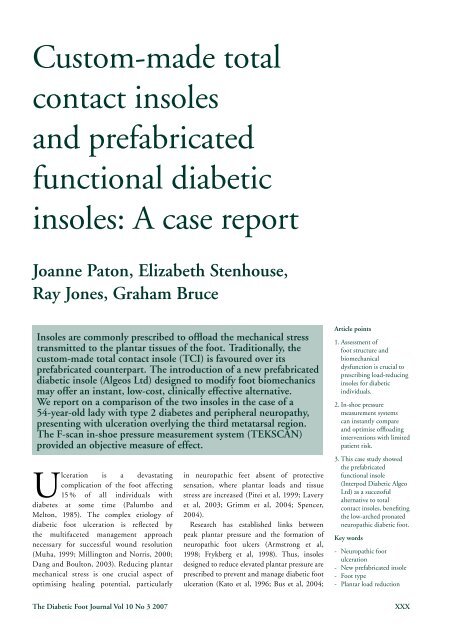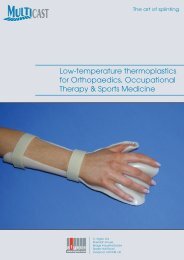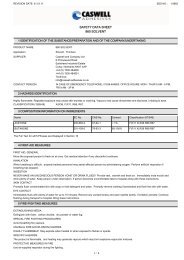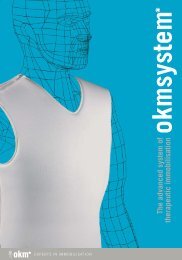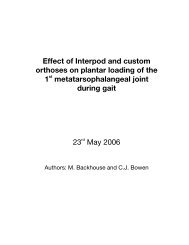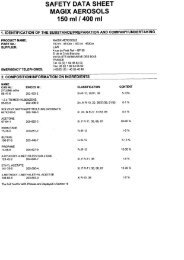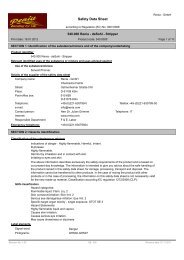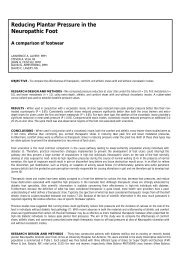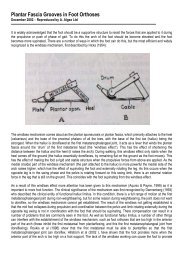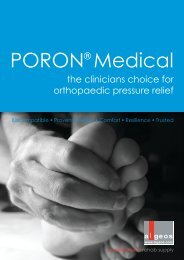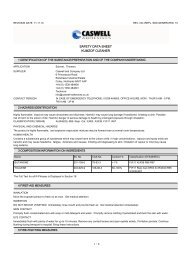Custom-made total contact insoles and prefabricated ... - Algeos
Custom-made total contact insoles and prefabricated ... - Algeos
Custom-made total contact insoles and prefabricated ... - Algeos
Create successful ePaper yourself
Turn your PDF publications into a flip-book with our unique Google optimized e-Paper software.
<strong>Custom</strong>-<strong>made</strong> <strong>total</strong><br />
<strong>contact</strong> <strong>insoles</strong><br />
<strong>and</strong> <strong>prefabricated</strong><br />
functional diabetic<br />
<strong>insoles</strong>: A case report<br />
Joanne Paton, Elizabeth Stenhouse,<br />
Ray Jones, Graham Bruce<br />
Insoles are commonly prescribed to offload the mechanical stress<br />
transmitted to the plantar tissues of the foot. Traditionally, the<br />
custom-<strong>made</strong> <strong>total</strong> <strong>contact</strong> insole (TCI) is favoured over its<br />
<strong>prefabricated</strong> counterpart. The introduction of a new <strong>prefabricated</strong><br />
diabetic insole (<strong>Algeos</strong> Ltd) designed to modify foot biomechanics<br />
may offer an instant, low-cost, clinically effective alternative.<br />
We report on a comparison of the two <strong>insoles</strong> in the case of a<br />
54-year-old lady with type 2 diabetes <strong>and</strong> peripheral neuropathy,<br />
presenting with ulceration overlying the third metatarsal region.<br />
The F-scan in-shoe pressure measurement system (TEKSCAN)<br />
provided an objective measure of effect.<br />
Ulceration is a devastating<br />
complication of the foot affecting<br />
15 % of all individuals with<br />
diabetes at some time (Palumbo <strong>and</strong><br />
Melton, 1985). The complex etiology of<br />
diabetic foot ulceration is reflected by<br />
the multifaceted management approach<br />
necessary for successful wound resolution<br />
(Muha, 1999; Millington <strong>and</strong> Norris, 2000;<br />
Dang <strong>and</strong> Boulton, 2003). Reducing plantar<br />
mechanical stress is one crucial aspect of<br />
optimising healing potential, particularly<br />
in neuropathic feet absent of protective<br />
sensation, where plantar loads <strong>and</strong> tissue<br />
stress are increased (Pitei et al, 1999; Lavery<br />
et al, 2003; Grimm et al, 2004; Spencer,<br />
2004).<br />
Research has established links between<br />
peak plantar pressure <strong>and</strong> the formation of<br />
neuropathic foot ulcers (Armstrong et al,<br />
1998; Frykberg et al, 1998). Thus, <strong>insoles</strong><br />
designed to reduce elevated plantar pressure are<br />
prescribed to prevent <strong>and</strong> manage diabetic foot<br />
ulceration (Kato et al, 1996; Bus et al, 2004;<br />
Article points<br />
1. Assessment of<br />
foot structure <strong>and</strong><br />
biomechanical<br />
dysfunction is crucial to<br />
prescribing load-reducing<br />
<strong>insoles</strong> for diabetic<br />
individuals.<br />
2. In-shoe pressure<br />
measurement systems<br />
can instantly compare<br />
<strong>and</strong> optimise offloading<br />
interventions with limited<br />
patient risk.<br />
3. This case study showed<br />
the <strong>prefabricated</strong><br />
functional insole<br />
(Interpod Diabetic Algeo<br />
Ltd) as a successful<br />
alternative to <strong>total</strong><br />
<strong>contact</strong> <strong>insoles</strong>, benefiting<br />
the low-arched pronated<br />
neuropathic diabetic foot.<br />
Key words<br />
- Neuropathic foot<br />
ulceration<br />
- New <strong>prefabricated</strong> insole<br />
- Foot type<br />
- Plantar load reduction<br />
The Diabetic Foot Journal Vol 10 No 3 2007<br />
XXX
<strong>Custom</strong>-<strong>made</strong> <strong>total</strong> <strong>contact</strong> <strong>insoles</strong> <strong>and</strong> <strong>prefabricated</strong> functional diabetic <strong>insoles</strong>: A case report<br />
Page points<br />
1. Expensive <strong>and</strong> time<br />
consuming to produce,<br />
<strong>total</strong> <strong>contact</strong> <strong>insoles</strong> may<br />
be inadequate to address<br />
all foot types.<br />
2. Insole provision for<br />
low-arched, pronated<br />
neuropathic feet should<br />
consider the already high<br />
<strong>total</strong> plantar <strong>contact</strong><br />
area <strong>and</strong> medial forefoot<br />
pressure distribution.<br />
3. Determining best insole<br />
design <strong>and</strong> fabrication<br />
for individual need is<br />
currently dependent upon<br />
clinical experience <strong>and</strong><br />
anecdotal evidence.<br />
4. This report compares<br />
the custom <strong>total</strong><br />
<strong>contact</strong> insole with the<br />
<strong>prefabricated</strong> functional<br />
insole in the case of a<br />
54-year-old lady with<br />
type 2 diabetes <strong>and</strong><br />
peripheral neuropathy,<br />
presenting with an<br />
ulceration overlying the<br />
third metatarsal region.<br />
Spencer, 2004). Traditionally used, the custom<br />
<strong>total</strong> <strong>contact</strong> insole reduces peak pressure by<br />
maximising <strong>total</strong> plantar <strong>contact</strong> area (Bus<br />
et al, 2004). Expensive <strong>and</strong> time consuming<br />
to produce, <strong>total</strong> <strong>contact</strong> <strong>insoles</strong> may be<br />
inadequate to address all foot types with<br />
diabetes-related biomechanical dysfunction,<br />
influential to plantar load distribution <strong>and</strong><br />
mechanical tissue stress (Mueller et al, 2003;<br />
Morag <strong>and</strong> Cavanagh, 1999).<br />
Insole provision for low-arched, pronated<br />
neuropathic feet should consider the already<br />
high <strong>total</strong> plantar <strong>contact</strong> area <strong>and</strong> medial<br />
forefoot pressure distribution (Mueller et<br />
al, 1990). In this foot type, the potential<br />
increase in plantar <strong>contact</strong> area generated<br />
by the <strong>total</strong> <strong>contact</strong> insole is relatively<br />
small; therefore, a functional insole design<br />
modifying the timing <strong>and</strong> direction of load<br />
transfer through the foot may be indicated.<br />
The <strong>prefabricated</strong> interpod diabetic insole<br />
(<strong>Algeos</strong> Ltd) is one such functional device<br />
incorporating biomechanical features<br />
believed to benefit the low-arched foot.<br />
Determining best insole design <strong>and</strong><br />
fabrication for individual need is currently<br />
dependent upon clinical experience <strong>and</strong><br />
anecdotal evidence. The ability of an insole<br />
to achieve its treatment objective is evaluated<br />
only after wear by clinical outcome at follow<br />
up; a perilous strategy for neuropathic<br />
individuals unable to detect the adverse<br />
affects of tissue damage by protective<br />
sensory feedback. The advancement of inshoe<br />
pressure measurement systems offering<br />
immediate objective measures of mechanical<br />
plantar load affords healthcare professionals<br />
the capacity to instantly compare <strong>and</strong><br />
optimise offloading interventions with<br />
limited risk to the individual.<br />
This report compares the custom <strong>total</strong><br />
<strong>contact</strong> insole with the <strong>prefabricated</strong><br />
functional insole in the case of a 54-yearold<br />
lady with type 2 diabetes <strong>and</strong> peripheral<br />
neuropathy, presenting with an ulceration<br />
overlying the third metatarsal region.<br />
The F-scan in-shoe pressure measurement<br />
system (TEKSCAN) informs treatment<br />
choice.<br />
Case study details<br />
Mrs X is a 54-year-old female presenting<br />
with a 4-year history of ulceration<br />
underlying the right third metatarsal head.<br />
Following the onset of osteomylitis <strong>and</strong><br />
subsequent systemic illness, she underwent<br />
emergency surgery to remove metatarsal<br />
heads two, three <strong>and</strong> four, leaving the toes<br />
intact. After 7 months, the wound cavity<br />
healed but following complications dehissed<br />
(Figure 1). Despite <strong>total</strong> <strong>contact</strong> <strong>insoles</strong> <strong>and</strong><br />
therapeutic footwear, the wound remained.<br />
Displaying a low-arch profile <strong>and</strong> pronated<br />
foot type, Mrs X seemed suitable to benefit<br />
from the newly available <strong>prefabricated</strong><br />
functional insole (Interpod Diabetic insole,<br />
<strong>Algeos</strong> Ltd). To inform best practice, the<br />
option of substituting <strong>insoles</strong> was objectively<br />
evaluated using the F-scan in-shoe pressure<br />
measurement system (TEKSCAN).<br />
Intervention<br />
<strong>Custom</strong>-<strong>made</strong> <strong>total</strong>-<strong>contact</strong> insole<br />
Produced from a semi-weight bearing foam<br />
box foot impression, the custom <strong>total</strong> <strong>contact</strong><br />
insole comprised a full-length medium EVA<br />
Figure 1. Ulceration with use of custom-<strong>made</strong> <strong>total</strong><strong>contact</strong><br />
insole.<br />
XXX The Diabetic Foot Journal Vol 10 No 3 2007
<strong>Custom</strong>-<strong>made</strong> <strong>total</strong> <strong>contact</strong> <strong>insoles</strong> <strong>and</strong> <strong>prefabricated</strong> functional diabetic <strong>insoles</strong>: A case report<br />
shell shaped to mirror the contours of the<br />
foot, covered with 6 mm poron (Figure 2).<br />
Functional <strong>prefabricated</strong> insole<br />
Fitted to foot size, the Interpod Diabetic<br />
insole (<strong>Algeos</strong> Ltd) consisted of a<br />
<strong>prefabricated</strong> full-length polyurethane<br />
contoured shell covered in 3 mm poron<br />
96. The device incorporated a six-degree<br />
bi-planar medial rearfoot skive <strong>and</strong> plantar<br />
fascia grove (Figure 2).<br />
Instrumentation<br />
The F-scan in-shoe pressure analysis system<br />
collected dynamic data from beneath the<br />
ulcerated foot. The high spatial resolution<br />
of the F-scan detects discrete areas of high<br />
pressure under individual metatarsal heads,<br />
clinically useful information for at-risk<br />
foot management (Lord, 1997). The F-scan<br />
in-shoe sensor consists of 960 sensels (four<br />
cells per cm²) integrated into a 0.15-mm-thick<br />
flexible polymer insole. Once cut to size, the<br />
sensors were calibrated in accordance with<br />
manufacturer recommendations. Six to seven<br />
consecutive steps were recorded per trial at a<br />
sampling frequency of 50 Hz, disregarding<br />
the first <strong>and</strong> last step to exclude the effects of<br />
gait acceleration <strong>and</strong> deceleration.<br />
Outcome measures<br />
Five preselected outcome measures compared<br />
effectiveness of the two <strong>insoles</strong> in terms of<br />
plantar load distribution <strong>and</strong> mechanical<br />
control:<br />
l Peak plantar pressure<br />
l Total plantar <strong>contact</strong> area<br />
l Rate of forefoot load (Figure 3)<br />
l Forefoot pressure time integral<br />
l Duration of metatarsal region load as a<br />
percentage of stance (Figure 4).<br />
Duration of load as a percentage of stance<br />
for the <strong>total</strong> <strong>contact</strong> insole condition showed<br />
greater percent load duration for the first<br />
metatarsophalangeal joint (MTP) relative<br />
to the fifth MTP. By contrast, the reverse<br />
effect was recorded using the <strong>prefabricated</strong><br />
insole (Table 2). When compared, the <strong>total</strong><br />
<strong>contact</strong> insole increased <strong>total</strong> <strong>contact</strong> area by<br />
a further 18 % (Table 1).<br />
The <strong>prefabricated</strong> insole (<strong>Algeos</strong> Ltd)<br />
was 20 % more efficient in reducing<br />
forefoot pressure time integral (Table 1).<br />
This information endorsed the treatment<br />
decision to prescribe the <strong>prefabricated</strong><br />
functional insole. Four weeks following the<br />
Force (kg)<br />
150<br />
100<br />
Figure 2. Left: <strong>prefabricated</strong><br />
functional insole (Interpod<br />
Diabetic insole; Algeo Ltd).<br />
Right: <strong>Custom</strong>-<strong>made</strong> <strong>total</strong><strong>contact</strong><br />
insole.<br />
Figure 3. F-scan display of forefoot force time curve. Rate of forefoot load is calculated by<br />
the time taken to reach peak force; the steepness of the slope.<br />
Results<br />
The F-scan in-shoe pressure measurement<br />
system (TEKSCAN) showed similar changes<br />
in mean peak pressure <strong>and</strong> rate of forefoot load<br />
(Table 1); the proposed <strong>prefabricated</strong> (<strong>Algeos</strong><br />
Ltd) insole appeared comparable in effect to<br />
the current <strong>total</strong> <strong>contact</strong> insole (TCI).<br />
50<br />
0<br />
0<br />
2 4 4 8<br />
Time (s)<br />
The Diabetic Foot Journal Vol 10 No 3 2007<br />
XXX
<strong>Custom</strong>-<strong>made</strong> <strong>total</strong> <strong>contact</strong> <strong>insoles</strong> <strong>and</strong> <strong>prefabricated</strong> functional diabetic <strong>insoles</strong>: A case report<br />
Figure 4. F-scan display<br />
showing position of TAM<br />
boxes. F-scan TAM analysis<br />
softwear computes the mean<br />
duration <strong>and</strong> range of each<br />
box’s load as a percentage of<br />
stance.<br />
issue of the <strong>prefabricated</strong> insole, the ulcer<br />
healed, although Mrs X’s general health <strong>and</strong><br />
mobility had declined (Figure 5).<br />
Discussion<br />
Comparison of F-scan data suggested<br />
both <strong>insoles</strong> had a similar effect on peak<br />
pressure. No data were collected without<br />
<strong>insoles</strong>; therefore, the actual reduction<br />
in peak pressure with <strong>insoles</strong> in shoe was<br />
unknown. Collecting in-shoe pressure data<br />
without offloading the foot would have<br />
placed the individual at unnecessary risk of<br />
further tissue damage. Moreover, although<br />
studies indicate <strong>insoles</strong> reduce peak pressure<br />
(Viswanathan et al, 2004), the magnitude<br />
of reduction deemed clinically significant is<br />
undetermined <strong>and</strong> not essential in this case.<br />
The <strong>total</strong> <strong>contact</strong> insole increased <strong>total</strong><br />
plantar <strong>contact</strong> area 18 % more than the<br />
<strong>prefabricated</strong> insole <strong>and</strong> yet mean peak<br />
pressure was similar for both. Simply<br />
increasing <strong>total</strong> plantar <strong>contact</strong> area<br />
during gait may not therefore be the only<br />
mechanism of reducing peak pressure.<br />
Duration of load as a percentage of stance<br />
with the <strong>total</strong> <strong>contact</strong> insole recorded initial<br />
<strong>and</strong> longer medial forefoot ground <strong>contact</strong>.<br />
This forefoot load pattern is undesirable<br />
in the presence of medial forefoot lesions<br />
but typical of excessively pronated feet<br />
(Bevans, 1992; Perry, 1992). By contrast, the<br />
<strong>prefabricated</strong> function insole reversed the<br />
trend; the lateral forefoot loaded first <strong>and</strong><br />
longer.<br />
The <strong>prefabricated</strong> functional insole<br />
reduced the forefoot pressure time integral<br />
by 20 % more than the custom-<strong>made</strong><br />
insole. The pressure–time integral has<br />
Table 1. Comparison of <strong>insoles</strong>: Magnitude <strong>and</strong> distribution of load.<br />
Outcome measure<br />
Total <strong>contact</strong> insole Prefabricated insole<br />
Mean peak pressure 1346 kPa 1353 kPa<br />
Total <strong>contact</strong> area 14348 mm 2 11742 mm 2<br />
Rate of forefoot load 259.5 Kg/sec 282.7 Kg/sec<br />
Forefoot pressure time integral 61.8 kPa*sec 49.5 kPa*sec<br />
been associated with ulceration in the<br />
neuropathic foot <strong>and</strong> may be more sensitive<br />
than peak pressure in detecting areas of<br />
increased ulceration risk (Stacpoole-Shea et<br />
al, 1999). The pressure–time integral, that<br />
is the product of magnitude of pressure <strong>and</strong><br />
duration of load, reflects areas exposed to<br />
short periods of very high pressure, <strong>and</strong> also<br />
areas of lower pressure but longer duration.<br />
Although objective evaluation of kinetic<br />
data supported the clinical decision to<br />
prescribe the <strong>prefabricated</strong> functional insole,<br />
we are unable to confirm that its use led<br />
to wound healing, particularly given the<br />
decline in Mrs X’s health <strong>and</strong> activity levels<br />
over the following weeks.<br />
Foot structure <strong>and</strong> biomechanical<br />
dysfunction are clearly relevant to plantar<br />
load distribution, neuropathic diabetic<br />
ulceration <strong>and</strong> ulcer site (Mueller et al,<br />
1990; Bevans, 1992; Cavanagh et al,<br />
2000). The provision of <strong>total</strong>-<strong>contact</strong><br />
<strong>insoles</strong> without attention to foot type<br />
<strong>and</strong> function may not achieve optimal<br />
reduction in plantar load in all cases. The<br />
new <strong>prefabricated</strong> functional insole (<strong>Algeos</strong><br />
Ltd) now offers an instant option designed<br />
to address poor mechanics in individuals<br />
with diabetes <strong>and</strong> neuropathy presenting<br />
with low-arched, pronated feet. This case<br />
illustrates how the <strong>prefabricated</strong> functional<br />
insole may provide a successful alternative to<br />
the <strong>total</strong> <strong>contact</strong> insole. Further evidence is<br />
required to support the use of <strong>prefabricated</strong><br />
functional <strong>insoles</strong> in the management of<br />
diabetic neuropathic feet.<br />
Conclusion<br />
The <strong>prefabricated</strong> functional insole (<strong>Algeos</strong><br />
Ltd) offered a successful alternative to<br />
the <strong>total</strong> <strong>contact</strong> insole, emphasising the<br />
importance of considering foot biomechanics<br />
to prescribe load-reducing <strong>insoles</strong> in ulcer<br />
prevention <strong>and</strong> management.<br />
Two important issues need investigation to<br />
improve load-reducing methods <strong>and</strong> better<br />
treat the neuropathic diabetic foot:<br />
l the role of <strong>prefabricated</strong> <strong>insoles</strong><br />
l the application of biomechanics principles.<br />
XXX The Diabetic Foot Journal Vol 10 No 3 2007
<strong>Custom</strong>-<strong>made</strong> <strong>total</strong> <strong>contact</strong> <strong>insoles</strong> <strong>and</strong> <strong>prefabricated</strong> functional diabetic <strong>insoles</strong>: A case report<br />
Figure 5. Resolution of ulcer with use of the<br />
<strong>prefabricated</strong> functional insole.<br />
Acknowledgements<br />
Thank you to Tania Woodrow, Diabetic<br />
Specialist Podiatrist, for her help with this<br />
study. The <strong>prefabricated</strong> <strong>insoles</strong> used in this<br />
project were supplied by <strong>Algeos</strong> Ltd.<br />
Author details<br />
Joanne Paton is a Podiatry Lecturer; Elizabeth<br />
Stenhouse is a Senior Lecturer; <strong>and</strong> Ray Jones is a<br />
Professor of Health Informatics, all in the Faculty<br />
of Health <strong>and</strong> Social Work, University of Plymouth.<br />
Graham Bruce is a Diabetic Specialist Podiatrist at<br />
Plymouth Teaching PCT.<br />
Armstrong D, Peters E, Athanasiou K et al (1998)<br />
Is there a critical level of plantar foot pressure<br />
to identify patients at risk for neuropathic foot<br />
ulceration The Journal of Foot <strong>and</strong> Ankle Surgery 37:<br />
303–7<br />
Bevans J (1992) Biomechanics <strong>and</strong> plantar ulcers in<br />
diabetes. The Foot 2: 166–72<br />
Bus S, Ulbrecht J, Cavanagh P (2004) Pressure relief<br />
<strong>and</strong> load redistribution by custom-<strong>made</strong> <strong>insoles</strong><br />
in diabetic patients with neuropathy <strong>and</strong> foot<br />
deformity. Clinical Biomechanics 19: 629–38<br />
Cavanagh P, Ulbrecht J, Caputo G (2000) New<br />
developments in the biomechanics of the diabetic<br />
foot. Diabetes/Metabolism Research <strong>and</strong> Reviews 16:<br />
S6–10<br />
Dang CN, Boulton AJM (2003) Changing perspectives<br />
in diabetic foot ulcer management. The International<br />
Journal of Lower Extremity Wounds 2: 4–12<br />
Frykberg RG, Lavery LA, Pham H et al (1998) Role of<br />
neuropathy <strong>and</strong> high foot pressures in diabetic foot<br />
ulceration. Diabetes Care 21: 1714–9<br />
Grimm A, Kastenbauer T, Sauseng S et al (2004)<br />
Progression <strong>and</strong> distribution of plantar pressure<br />
in type 2 diabetic patients. Diabetic Nutrition <strong>and</strong><br />
Metabolism 17: 108–13<br />
Kato H, Takada T, Kawamura T et al (1996) The<br />
reduction <strong>and</strong> redistribution of plantar pressures<br />
using foot orthoses in diabetic patients. Diabetes<br />
Research in Clinical Practice 31: 115–8<br />
Lavery L, Armstrong D, Wunderlich R et al (2003)<br />
Predictive value of foot pressure assessment as part<br />
of a population based diabetes disease management<br />
program. Diabetes Care 26: 1069<br />
Lord M (1997) Spatial resolution in plantar pressure<br />
measurement. Medical Engineering <strong>and</strong> Physics 19:<br />
140–4<br />
Millington JT, Norris TW (2000) Effective treatment<br />
strategies for diabetic foot wounds. The Journal of<br />
Family Practice 49: S40–8<br />
Morag E, Cavanagh P (1999) Structural <strong>and</strong> functional<br />
predictors of regional peak pressures under the foot<br />
during walking. Journal of Biomechanics 32: 359–70<br />
Mueller M, Minor S, Diamond J et al (1990)<br />
Relationship of foot deformity to ulcer location in<br />
patients with diabetes mellitus. Physical Therapy 70:<br />
356–62<br />
Mueller M, Hastings M, Commean P et al (2003)<br />
Forefoot structural predictors of plantar pressures<br />
during walking in people with diabetes <strong>and</strong><br />
peripheral neuropathy. Journal of Biomechanics 36:<br />
1009–17<br />
Muha J (1999) Local wound care in diabetic foot<br />
complications. Aggressive risk management <strong>and</strong><br />
ulcer treatment to avoid amputation. Postgraduate<br />
Medicine 106: 97–102<br />
Palumbo P, Melton L (1985) Peripheral vascular disease<br />
<strong>and</strong> diabetes. Washington: US Government Printing<br />
Office.<br />
Perry J (1992) Gait Analysis Normal <strong>and</strong> Pathological<br />
Function. New Jersey: Slack Inc.<br />
Pitei D, Lord M, Forster A et al (1999) Plantar<br />
pressures are elevated in the neuroischeamic <strong>and</strong> the<br />
neuropathic diabetic foot. Diabetes Care 22: 1966<br />
Spencer S (2004) Pressure relieving interventions<br />
for preventing <strong>and</strong> treating diabetic foot ulcers.<br />
Cochrane Database of Systemic Reviews 3: CD002302<br />
Stacpoole-Shea S, Shea G, Lavery L (1999) An<br />
examination of plantar pressure measurements to<br />
identify the location of diabetic forefoot ulceration.<br />
Journal of Foot <strong>and</strong> Ankle Surgery 38: 109–15<br />
Viswanathan V, Madhavan S, Gnanasundaram S et al<br />
(2004) Effectiveness of different types of footwear<br />
<strong>insoles</strong> for the diabetic neuropathic foot. Diabetic<br />
Care 27: 474–7<br />
Table 2. Comparison of <strong>insoles</strong>: Timing of forefoot load.<br />
Duration of load as Total <strong>contact</strong> insole Prefabricated insole<br />
percentage of stance Mean Range Mean Range<br />
1st metatarsal head 79 73–82 75 41–89<br />
2nd metatarsal head 77 70–82 72 43–87<br />
3rd–4th metatarsal head 78 70–81 80 70–85<br />
5th metatarsal head 65 31–83 81 70–88<br />
The Diabetic Foot Journal Vol 10 No 3 2007<br />
XXX


